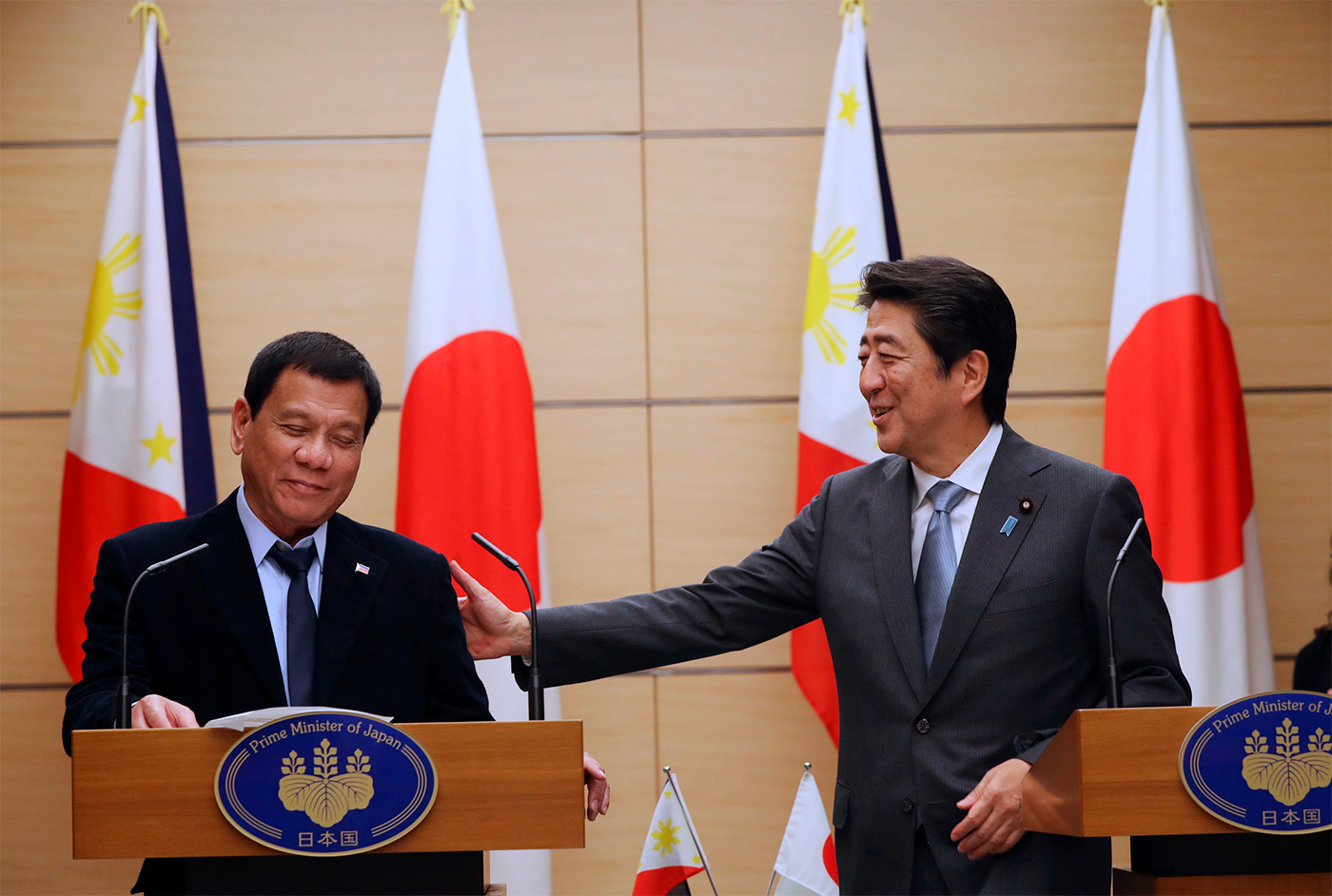Japan and Duterte’s Manoeuvres: Regional Bipolarity or Multi-Vector Politics?
In
Login if you are already registered
(no votes) |
(0 votes) |
On October 25–27, President of the Philippines Rodrigo Duterte paid his first visit to Japan. The controversial leader used the occasion to secure an economic and defence cooperation deal with Prime Minister of Japan Minister Shinzo Abe, as well as to demand that the U.S. military bases be withdrawn from the Philippines. This is a plot that the New Asian Perspectives blog finds all too familiar.
Although his brash rhetoric has already earned Rodrigo Duterte a reputation of being the new Hugo Chavez (it would be enough to remember Chavez’s statement that President George W. Bush smelled of sulphur), it is too early to expect a drastic turn in the policies of Manila. The new leader of the Philippines managed to exchange words with President of the United States Barack Obama at the ASEAN summit, despite his earlier insulting statements regarding the latter, and he will most likely find time for a similar meeting on the sidelines of the November APEC summit in Peru. It is also worth asking whether or not Duterte would have kept up his rhetoric had Obama not been a “lame duck,” and had the United States’ foreign policy in Asia not been at a crossroads between the likely policies of Hillary Clinton (to increase the presence of the United States in the region) on the one hand and Donald Trump (to possibly reduce this presence) on the other. Relations between the Philippines, a U.S. colony until 70 years ago, and the United States show one of the intrinsic problems of all unequal alliances: the “junior” partner fears abandonment, which prompts it to simultaneously hedge its bets and play hard to get. Finally, Duterte’s rapprochement with China should also be considered as a kind of “sweetening the pill” in a bid to alleviate possible negative effects of Manila’s recent victory in the case regarding disputed areas in the South China Sea. The Philippines’ claim in the case was actively supported by both Japan and the United States.

REUTERS/Eugene Hoshiko/Pool
Rodrigo Duterte and Shinzo Abe
Interestingly enough, just as many foreign affairs experts were debating how exactly China was going to test the system of U.S. alliances in East Asia (in the South China Sea, for example), the system was actually tested by the United States’ regional allies themselves. Since China has been gradually building up its influence as a second pole in the Asian international order, thus fuelling deepening concerns in Washington, the conditions are now favourable for the partners of the United States in Asia to hike up the price of their cooperation. Meanwhile, the burden of paying the new adjusted price is often shared with Japan. However, Japanese diplomacy is not just about sharing in the financial burden: Tokyo wants to become a balancing force in the region and ensure its economic security.
During the President of the Philippine’s recent visit, the Japanese leadership focused on bilateral cooperation in maritime security, various economic projects and loans worth a total of $210 million. While the amount promised by Japan seemingly pales in comparison to the $24 billion recently pledged to the Philippines by China, this is in fact misleading. Japan has been one of the Philippine’s key economic partners since the middle of the 20th century, accounting for 14.5 per cent of that country’s foreign trade turnover. In 2015, over 16 per cent of the total foreign direct investment in the Philippines came from Japan. Philippine companies have been an important link in the value chains of Japanese corporations for decades now. Japan’s “soft power” is also obvious in Manila, from signs expressing gratitude to the Japan International Cooperation Agency (JICA) for financing this or that infrastructure object to the ubiquitous pop culture and lifestyle. The securitization and strategizing of Japan’s development assistance, which has taken a distinct shape during Shinzo Abe’s second term in office, has influenced the country’s relations with the Philippines as well. For instance, the Philippine Coast Guard has repeatedly received Japanese motor boats (including during Duterte’s visit to Tokyo), while Japanese and U.S. analysts cited the Philippines and Vietnam as the most promising security partners in Southeast Asia, and the Asian Development Bank, at the suggestion of Japan, increased the limit of financing for Manila.
Duterte’s rhetoric against Washington to a certain extent resembles Central Asia of the mid-2000s. At the 2005 Shanghai Cooperation Organisation (SCO) summit in Astana, the SCO members adopted a statement demanding a “definitive timeline” for the withdrawal of U.S. forces from military bases in the region. At the demand of the Ministry of Foreign Affairs of Uzbekistan, U.S. air forces were pulled out from the Karshi-Khanabad Air Base. Although, if experts are to be believed, this was against the wishes of the military authorities of the two countries. Russian air forces had been deployed at the base until Tashkent turned to the West once again, which resulted in its suspension of its membership with the Collective Security Treaty Organization (CSTO) in 2012. Kyrgyzstan, however, managed to successfully swing back and forth between Moscow and Washington, collecting lease payments simultaneously for the Russian Kant Air Base and the U.S. Manas Air Base (renamed the Transit Center at Manas in 2009) up until 2014. At the time, one of the goals behind the intensification of ties with Central Asian nations during the term of Junichiro Koizumi was to prevent them from leaning too heavily towards Moscow or Beijing, including through financing, although bilateral assistance to Tashkent, for one, was minimized after the violent events in Andijan in 2005. Certain experts even described Tokyo as assuming the role of “good cop,” helping out Washington with a delicate issue on the ground. Yet, Prime Minister Shinzo Abe eventually decided to go along with Central Asia–Moscow relations, focusing on the rivalry with Beijing instead.
However, while Central Asia is not a vital region for Japan, the Philippines is quite the opposite, both in light of the bilateral economic relations described above and due to Japan’s reliance on the South China Sea as a key sea route. Therefore, President Rodrigo Duterte will probably get more opportunities to test Japan’s willingness to cajole its partners in the region in the foreseeable future. And although strengthening ties with Manila is in line with Tokyo’s political and economic interests, Duterte’s back-and-forth movement between China and Japan, if sustained over the long term, may create a precedent along the lines set by other Southeast Asian nations. How long the Japanese budget will be able to finance the “increasing multi-vector politics” of its partners aiming in the region, remains to be seen.
(no votes) |
(0 votes) |




